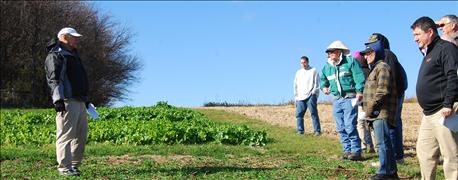
Iowa farmers have substantially changed their tillage and other farming practices in the past decade to conserve soil, reduce nutrient losses and improve water quality, says a new poll by Iowa State University. Results of the survey also show that farmers have invested as much as $2.2 billion to make the conservation improvements. Poll results are available at 2015 Iowa Farm and Rural Life Poll on the ISU website.
In this latest Iowa Farm & Rural Life poll, based on 1,159 responses, the farmers surveyed cited “stewardship ethics” as the biggest reason they are adopting environmentally-friendly practices. Decisions to adopt soil and water conservation

IOWA FARM POLL: Iowa State University recently released results of its latest farm poll. It shows the state’s farmers are taking an increased number of steps to better manage nutrients, protect water quality, reduce soil erosion and improve soil health.
practices are also influenced by concerns for water quality and concern about leaving the land in better shape for future generations, as well as economic concerns.
1. More are using practices that are more environmentally friendly
“The results indicate many farmers are adopting agronomic and conservation practices that are better for the environment,” says J. Gordon Arbuckle, an ISU Extension sociologist who conducts the survey. “We are seeing more emphasis on conservation. That was happening even before the Iowa Nutrient Reduction Strategy was launched in 2013 and is continuing.”
The poll shows in the last decade a sharp increase in soil testing and other methods to precisely determine optimum fertilization rates and to prevent over-application. In the poll 61% of farmers say there’s been a moderate or major increase in soil testing and other methods to determine optimal fertilizer rates. Iowa farmers are using more precision farming practices, such as variable rate fertilizer application, applying the right amount of fertilizer at the right time, as 57% report an increase in their use of precision farming practices.
2. Less nitrogen is being applied in the fall, more applied in-season
More farmers are moving away from fall-applied nitrogen application, with 36% saying they have made a moderate or major decrease. Conversely, there has been an increase of in-season applications, to provide plants the fertilizer N when they can best use it and help reduce nutrient losses. Farmers report those applications are up 38%.
The use of nitrogen stabilizers to help keep nitrogen fertilizer in the soil until plants can use the nutrient, is also increasing with 46% of the respondents reporting they are using a stabilizer with their nitrogen application.
3. More cover crops, more no-till and more permanent structures
More farmers are planting cover crops, with nearly 35% of respondents saying they’ve implemented a moderate or major increase in the practice. Over half of those surveyed (54%) say they’ve increased their use of conservation tillage methods that leave at least 30% of crop residue on the soil surface; 46% have increased their use of no-till.
There has been a significant gain in construction and installation of permanent practices such as terraces, grassed waterways and buffer strips. Over half (54%) of the farmers surveyed say they have installed more of these structures on their land.
The ISU poll also asked farmers about the reasons why they are using more soil conservation and water quality practices. Strong conservation ethics is a big reason for the increase. Almost half (48%) of the respondents cited ethics as having a strong or very strong influence on their decisions. Economics (43%) also has a very strong influence. Concern about water quality ranks third, with 33% saying its influence is strong or very strong in their decision-making on the farm.
4. What motivates farmers to practice environmental stewardship?
The largest number of respondents (81%) say they want to protect the land for the next generation of farmers. Other motivations for practicing environmental stewardship offered in the poll, which are rated as important are:
* Because it is the right thing to do (80%)
* Avoid polluting streams, rivers and lakes (80%)
* Protecting their personal investment in the land (78%)
5. Conservation spending by farmers is quite significant
In the survey, 88% of the farmers said they had invested money in conservation improvements during the past 10 years. The poll asked farmers to consider all their conservation expenses and all sources of funding, including cost-share from government programs.
Results show 30% of the respondents indicate they had spent up to $5,000 on conservation and water quality practices; 18% spent between $5,000 and $9,999 and 12% from $10,000 to $19,000. The poll found that 23% of the respondents had invested up to $74,999 in conservation projects and 5% invested more than that.
Conservation spending adds up, including farmers’ own money
“Those investments add up to billions of dollars when multiplied by the number of farmers in Iowa,” notes Arbuckle. He estimates Iowa farmers invested between $1.3 and $2.2 billion, including their own funds, along with cost-share and in-kind labor over the past decade.
Summing up: “Considering all the data gathered in this year’s survey, it shows that Iowa farmers have been making significant investments in soil and water conservation and water quality protection practices,” notes Arbuckle. “Of course, there’s still a lot of conservation work to do, but the results of our survey indicate things are moving in the right direction.”
The entire ISU Farm & Rural Life Poll can be found at store.extension.iastate.edu/product/pm3075.
About the Author(s)
You May Also Like




